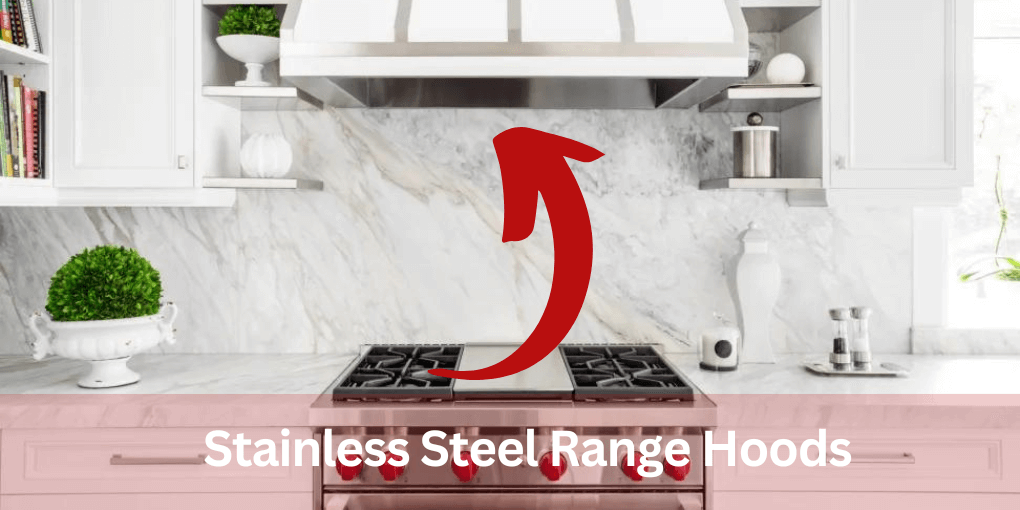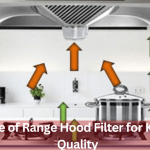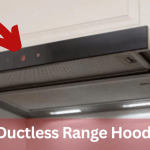A stainless steel range hood is a ventilation system that is installed above a cooking range or cooktop to remove smoke, steam, and other cooking odors from the kitchen.

The range hood helps to filter the air and prevent grease buildup, which can cause damage to the kitchen and appliances.
In addition to its functional benefits, a stainless steel range hood also adds a modern and stylish touch to the kitchen’s décor.
This blog post will explore the benefits, considerations, and maintenance tips for stainless steel range hoods
Explanation of what is a stainless steel range hood
Installation of a stainless steel range hood above a cooktop or range allows for the extraction of smoke, steam, and other cooking aromas from the kitchen.
It consists of a metal canopy or hood that covers the cooking area and collects smoke and steam, typically made of stainless steel.
A fan or blower is also a part of the range hood, and it pulls in the smoke and steam, filters it through a number of mesh or baffle filters, and then exhausts it outside via a duct or recirculating filter.
Due to its strength, ease of maintenance, and contemporary appearance, stainless steel is a preferred material for range hoods.
Other features found on some range hoods include illumination, adjustable fan speed, and timer settings.
Types of Stainless Steel Range Hoods
Stainless steel range hoods are a popular choice for many modern kitchens due to their durability, sleek design, and easy-to-clean surface. Here are some of the most common types of stainless steel range hoods:
Wall-mounted range hoods
These are attached to the wall above the cooktop and are the most common type of range hood. They come in different sizes and designs to fit different kitchen layouts and styles.
Island range hoods
These are mounted on the ceiling above an island cooktop and are ideal for kitchens with a cooking area located in the center of the room.
Under-cabinet range hoods
These are installed underneath a cabinet above the cooktop and are ideal for kitchens with limited space.
Ducted range hoods
These range hoods are connected to a duct that carries smoke and steam outside the house, providing efficient ventilation.
Ductless range hoods
These range hoods recirculate air back into the kitchen after filtering out smoke and steam. They don’t require a duct, making them easier to install but less efficient than ducted range hoods.
Convertible range hoods
These range hoods can be installed as either ducted or ductless. They provide flexibility for homeowners who may want to switch between the two in the future.
Pro-style range hoods
These range hoods are designed for serious home cooks and chefs, with high-powered fans and commercial-grade features.
Custom range hoods
These range hoods are made to order to fit the specific dimensions and design of your kitchen.
They can be a bit more expensive but provide a personalized touch to your cooking space.
Importance of range hoods in kitchens
Range hoods are an essential component of modern kitchens.
They serve a crucial function by improving air quality and providing ventilation while cooking. Here are some of the reasons why range hoods are important:
- When you cook, steam and smoke are produced, which can make the air in your kitchen uncomfortable and even harmful to breathe. Range hoods help remove smoke and steam from the air, improving the overall air quality in your kitchen.
- Cooking can produce strong odors that can linger for hours. Range hoods are equipped with filters that can remove these odors, leaving your kitchen smelling fresh.
- Range hoods help reduce the concentration of pollutants and irritants in the air, making it easier to breathe. This is especially important for those who suffer from allergies or asthma.
- Grease and oil produced during cooking can accumulate on surfaces and cause a fire hazard. Range hoods help prevent this buildup by capturing and filtering out grease particles.
- Range hoods also protect your kitchen from damage caused by smoke and steam. These elements can cause discoloration or damage to walls, cabinets, and other surfaces over time.
- Range hoods provide better visibility and lighting for cooking, making it easier to see what you’re doing and reducing the risk of accidents.
Benefits of Stainless Steel Range Hoods
Stainless steel range hoods offer a range of benefits that make them a popular choice for homeowners and chefs alike. Here are some of the key benefits:
Durability
Stainless steel is a highly durable material that resists corrosion, stains, and dents, making it a practical choice for a range hood.
These range hoods are built to last and can withstand the rigors of daily use.
Easy Maintenance
Stainless steel range hoods are easy to clean and maintain. They can be wiped down with a damp cloth or mild cleaning solution to remove grease and stains.
Additionally, stainless steel is resistant to bacteria and other harmful microorganisms, making it a hygienic choice for a kitchen appliance.
Modern Look
Stainless steel has a sleek and modern appearance that adds a touch of elegance to any kitchen décor.
It complements a range of kitchen styles, from contemporary to traditional, and can help to increase the value of the home.
Improved Ventilation
Stainless steel range hoods are designed to improve the ventilation of the kitchen. It helps to remove smoke, steam, and other cooking odors.
This helps to maintain healthy indoor air quality and reduces the risk of respiratory problems and other health hazards.
Increased Safety
Stainless steel range hoods help to prevent grease buildup and reduce the risk of fire hazards in the kitchen.
They also provide additional lighting for the cooking area, making it easier to monitor food and prevent accidents.
Installation and Maintenance
Installing and maintaining a stainless steel range hood is important to ensure its proper functioning and longevity. Here are some tips for installation and maintenance:
- Proper Installation: It is essential to have a professional install the range hood to ensure that it is properly vented and ducted to the outside. A properly installed range hood will operate more efficiently and last longer.
- Regular Cleaning: Regular cleaning of the range hood and its filters is important to maintain its efficiency and prevent the buildup of grease and debris. Filters should be cleaned or replaced every few months, depending on usage. Stainless steel surfaces can be cleaned with a mild detergent and water, and polished with a stainless steel cleaner to maintain its shine.
- Check Fan Motor: The fan motor should be checked periodically to ensure that it is functioning properly. A faulty fan motor can cause poor ventilation, increased noise, and increased energy consumption.
- Inspect Ductwork: The ductwork should be inspected to ensure that it is clear of any obstructions or damage that may reduce the efficiency of the range hood.
- Safety Precautions: When cleaning or maintaining the range hood, be sure to turn off the power. You should follow all safety precautions to prevent accidents.
Functionality and Performance
When selecting a stainless steel range hood, it is important to consider its functionality and performance. Here are some factors to consider:
Size
The size of the range hood should be proportional to the size of the cooktop or range it will be installed over. A range hood that is too small may not effectively remove smoke and cooking odors, while one that is too large may be overpowering and noisy.
CFM Rating
The CFM (cubic feet per minute) rating is an indication of the range hood’s ventilation power. The range hood’s power increases with the CFM rating.
It is important to select a range hood with a CFM rating that is appropriate for the size of the kitchen and the cooking needs.
Noise Level
Range hoods can be noisy, especially at higher CFM settings. Look for range hoods with low noise levels or adjustable fan speeds that allow for quieter operation.
Lighting
Range hoods often include lighting to illuminate the cooking surface. Look for range hoods with adjustable lighting settings or LED lighting for energy efficiency.
Controls
The controls for the range hood should be easy to use and accessible. Look for range hoods with push-button controls, touch controls, or remote controls for convenience.
Conclusion
A stainless steel range hood is a functional and stylish addition to any kitchen.
It provides ventilation to remove smoke, cooking odors, and excess heat, as well as adding a sleek and modern look.
When selecting a stainless steel range hood, it is important to consider its size, CFM rating, noise level, lighting, and controls.
Proper installation and maintenance, including regular cleaning and checking of the fan motor and ductwork. It ensures its proper functioning and longevity.
By investing in a high-quality stainless steel range hood, homeowners can enjoy a clean, comfortable, and stylish kitchen for years to come.

Freda is a passionate foodie and kitchen gadget enthusiast. With over 10 years of experience in the culinary industry, Freda brings her expertise in testing and reviewing kitchen gadgets.




